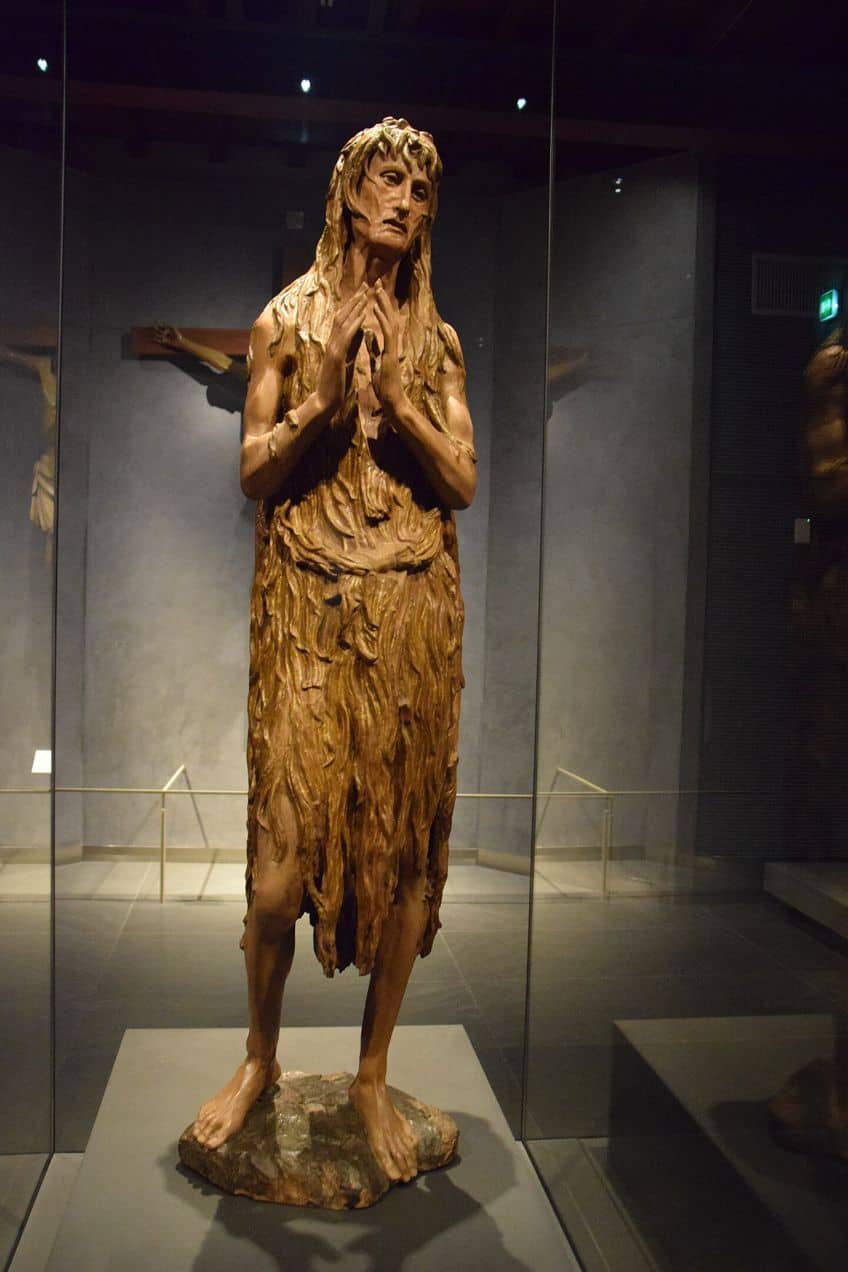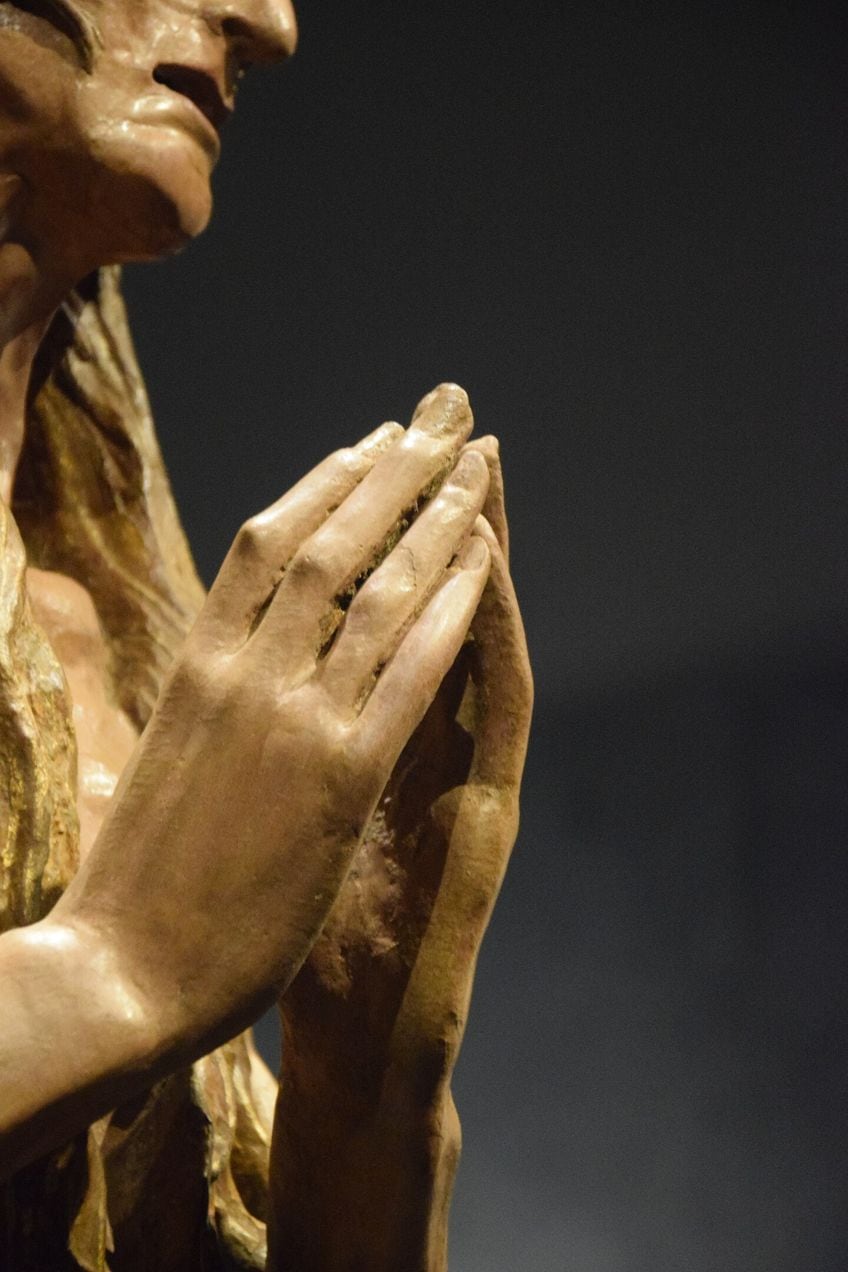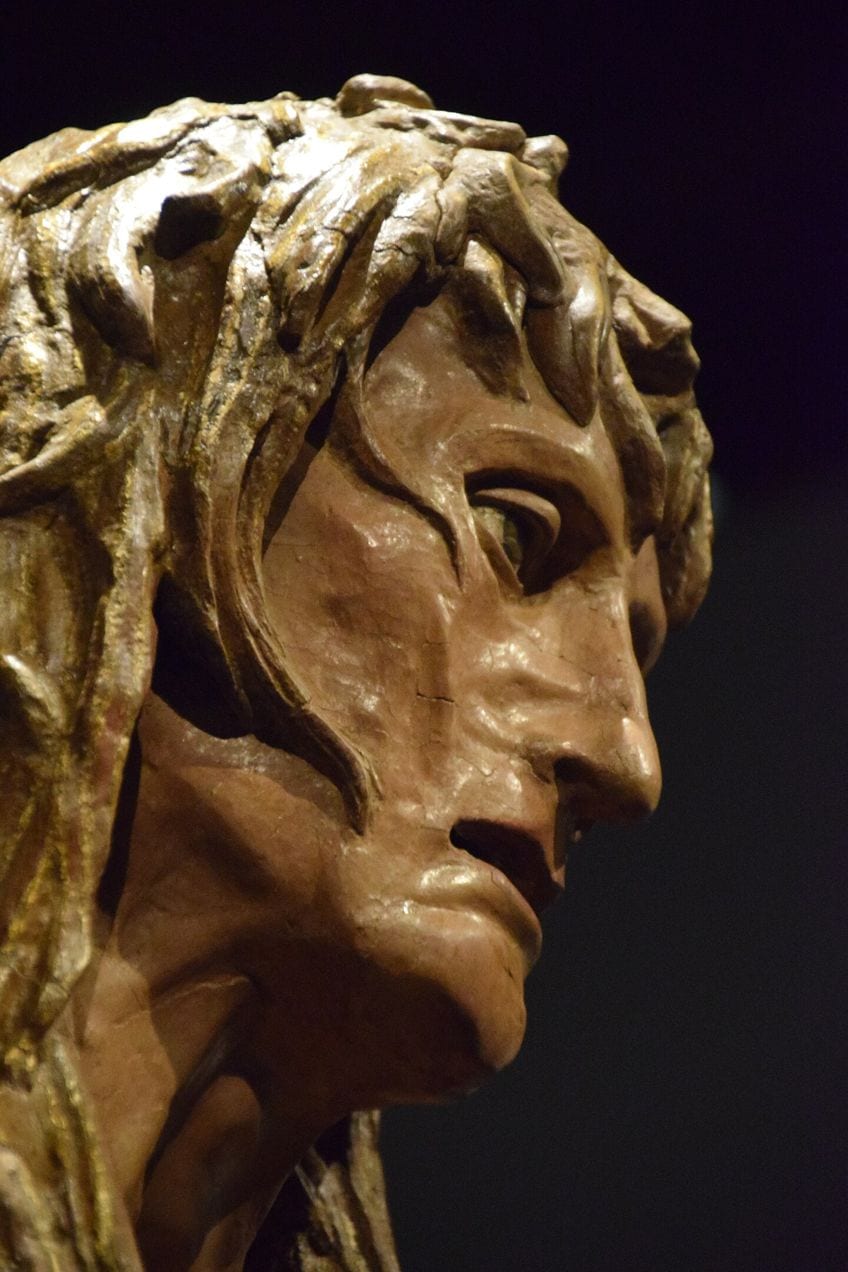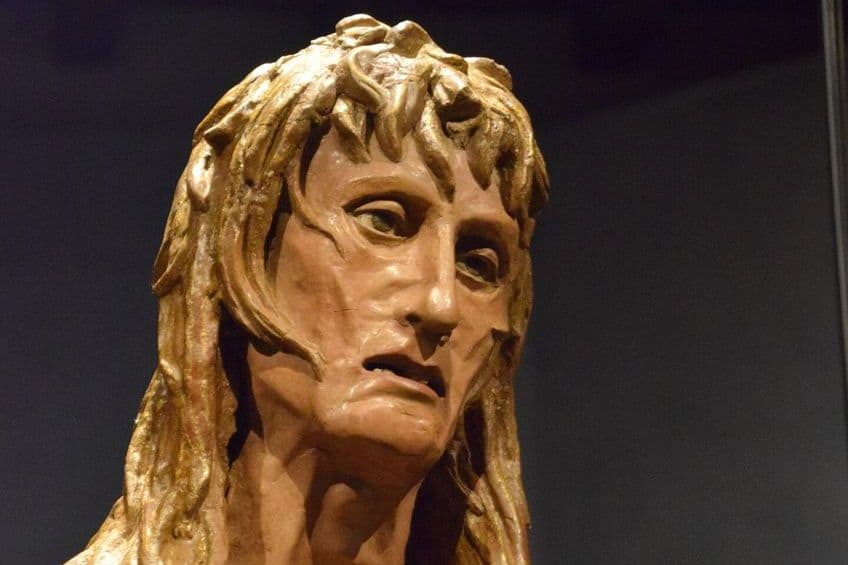“Penitent Magdalene” by Donatello – A Detailed Analysis
Donatello’s wooden Penitent Magdalene, crafted in the late 15th century, epitomizes his mastery of emotional expression. With haunting detail, the sculpture conveys the Magdalene’s sorrow and repentance, drawing viewers into a world of introspection. Through intricate carving and subtle features, Donatello captures human frailty and divine redemption, inviting timeless contemplation. As a cornerstone of Renaissance sculpture, the Penitent Magdalene remains a poignant exploration of faith and forgiveness by a master craftsman.
Key Takeaways
- Donatello’s Penitent Magdalene exemplifies revolutionary realism in Renaissance sculpture.
- The work is on display in the Museo dell’Opera del Duomo, reflecting its cultural significance in Florence.
- The sculpture is a testament to the themes of repentance and redemption in the Renaissance era.
Historical Context
| Artist | Donatello (c. 1386 – 1466) |
| Date Created | c. 1440 |
| Medium | Wood |
| Genre | Religious art |
| Period/Movement | Early Renaissance |
| Dimensions (cm) | Height: 188 |
| Series/Versions | N/A |
| Where Is It Housed? | Museo dell’Opera del Duomo, Florence, Italy |
| What It Is Worth | Invaluable (Priceless artwork) |
Situated in the Museo dell’Opera del Duomo in Florence, Italy, the Penitent Magdalene conveys a powerful message of both spiritual renewal and human frailty. Donatello, whose full name was Donato di Niccolò di Betto Bardi, was an influential figure in the early period of the Italian Renaissance, and his work continues to be admired for its innovative approach and its impact on the art that followed.
The Penitent Magdalene is a significant sculpture that reflects the artistic and religious milieu of 15th-century Florence and embodies the merging of Renaissance innovation and the devotional practices of its era.

Commission and Creation
Donatello, one of the most eminent sculptors of the Italian Renaissance, is believed to have created the Penitent Magdalene in the late 1440s. It is thought that the Florentine Confraternity, a religious group dedicated to piety and art, commissioned the wooden sculpture for the Baptistery of Florence, a central religious building of the city renowned for its dedicated artworks. The exact reason for the commission is not well-documented, but the choice of Mary Magdalene as a subject reflects the period’s emphasis on penitence and redemption.

Location and Migration
Initially placed within the Baptistery of Florence, the Penitent Magdalene, over the centuries, underwent various relocations. It suffered damage during the Arno River flood in 1966, after which it was moved to the Museo dell’Opera del Duomo for restoration and conservation. This museum is known for housing a collection of artworks created for the historic sites of Florence, including the Cathedral of Florence, commonly known as the Duomo, and its Baptistery.
The sculpture’s movement from its original religious context to a museum setting reflects the shift from viewing artworks as devotional objects to viewing them as cultural artifacts.
Formal Analysis
The sculpture of Penitent Magdalene by Donatello is a remarkable example of early Italian Renaissance art that demonstrates technical mastery and expressive realism. This section provides a detailed examination of the materials, stylistic elements, and iconography inherent in the work.

Materials Used
Donatello’s selection of white poplar wood for his sculpture was deliberate, as it enabled him to achieve intricate detailing and a lifelike appearance. The choice of wood carries significance, as it not only allows for the fine carving that characterizes the piece but also imparts a sense of warmth and authenticity to the work. The tactile realism for which the sculpture is celebrated is heightened by the properties of the white poplar wood, offering viewers a deeper engagement with the artwork’s form and texture.
Through the skillful manipulation of this material, Donatello masterfully captured the essence of his subject, creating a piece that continues to captivate audiences with its craftsmanship and lifelike presence

Stylistic Elements
Donatello’s sculpture stands as a testament to his mastery and artistic vision. The choice of material facilitated intricate detailing and imbued the work with a warmth that resonates with viewers. Renowned for its expressive qualities and departure from the idealized forms of the Gothic era, the sculpture marks a significant shift towards naturalism and humanization in art—a hallmark of the Renaissance.
Donatello skillfully captures the essence of his subject, Mary Magdalene, through the evocative portrayal of gaunt cheeks and hollowed eyes, stirring deep emotions in those who behold it.
The realism achieved in the sculpture is striking, evident in the gritty texture of Magdalene’s long hair and the weathered skin that speaks to a life of contemplation and devotion. Through his artistry, Donatello not only brings Mary Magdalene to life but also reflects the broader cultural and artistic shifts of his time, perpetuating a legacy that continues to inspire and captivate audiences across generations.

Iconography and Symbolism
Penitent Magdalene is rich in symbolism, particularly evident in Mary Magdalene’s cascading hair, a poignant symbol of her penitence and rejection of worldly vanity. The sculpture encapsulates themes of resilience, inner strength, and the triumph of the human spirit, emblematic of the burgeoning Renaissance era. Through his profound understanding of human emotion and narrative, Donatello masterfully imbues the sculpture with a sense of sorrow intertwined with spiritual fortitude, reflecting the complex emotions characteristic of Renaissance art. Giorgio Vasari, the esteemed art historian, praised Donatello’s ability to seamlessly weave these elements into a captivating narrative that continues to resonate with audiences today.
In its portrayal of Magdalene’s long hair, facial expression, and posture, the sculpture serves as a profound exploration of spiritual enlightenment and the human experience, inviting viewers to contemplate the depths of emotion and faith.

Cultural and Religious Implications
Donatello’s Penitent Magdalene is not only a remarkable sculpture but also a rich source of cultural and religious significance, portraying a transformation from sin to sanctity through penance. Mary Magdalene, often depicted as the quintessential penitent sinner in Christian art, is cast in Donatello’s sculpture in a particularly evocative way. She is neither idealized nor romanticized, but rather, presented with raw emotion and somber realism.
Mary Magdalene’s penitent state is underscored by her disheveled appearance, a stark contrast to typical representations of sainthood.
Her shaggy hair and gaunt form signify a prolonged period of fasting and penitence, aligned with religious narratives of her life after the resurrection of Christ. This sculpture challenges contemporary notions of beauty and virtue, emphasizing Mary Magdalene’s significance as a convert from a life shadowed by sin, perhaps even prostitution, to one of holiness.
Thematic Elements of Penance
The Penitent Magdalene delves into the themes of mortality and the transformative power of penance. Donatello presents not merely a figure from the Gospels but a symbolic embodiment of forgiveness and spiritual rebirth. The sculpture serves as an invitation to observe the internal struggle of a sinner in pursuit of redemption through self-denial and contrition. By accentuating her emaciated body and sorrowful expression, Donatello amplifies the notion that true penitence involves tangible sacrifice and personal suffering. The work communicates a powerful message that transcends its era, about the human capacity for change and the possibility of absolution through sincere repentance.

Restoration and Conservation
This section focuses on the challenges and efforts associated with the restoration and conservation of the Penitent Magdalene sculpture by Donatello. The Penitent Magdalene was crafted from white poplar wood, a material prone to degradation over time. Factors such as temperature fluctuations, humidity, and biological threats like insect infestation can cause significant damage. White poplar was chosen for its workability and availability, but being a softer wood, it requires meticulous care to preserve its integrity.
Historical records, including those by Giorgio Vasari, indicate the sculpture once bore a polychromatic finish, with stucco and gilding used to elevate its visual impact.
Modern Preservation Efforts
The Museo dell’Opera del Duomo, particularly the Sala della Maddalena, is the current custodian of this treasured artwork. Preservation of the sculpture has included restoring the once vibrant polychrome and gilding–layered techniques utilizing gold and colored pigments. Such restorations are delicate, often involving cleaning, consolidation, and in some cases, the application of materials compatible with the original work. Preservation efforts aim to stabilize the artwork, ensuring its longevity while respecting the original craftsmanship of Donatello.

Donatello’s Penitent Magdalene exemplifies the enduring power of Renaissance sculpture, captivating audiences with its portrayal of sorrow and redemption. Through meticulous detail, Donatello’s mastery of form and emotion shines, cementing his legacy as a visionary artist. As viewers engage with the sculpture, they are drawn into profound reflection on themes of faith and forgiveness, reminded of art’s ability to illuminate the human experience. The Penitent Magdalene stands as a timeless beacon of spiritual introspection, offering solace and inspiration across generations.
Frequently Asked Questions
What Is the Significance of Donatello’s Depiction of Mary Magdalene in the Sculpture?
Donatello’s sculpture presents Mary Magdalene as a deeply penitent figure, which marks a departure from traditional depictions that often emphasize her beauty and femininity. Instead, he chose to focus on her repentance and spirituality, reflecting a more human and relatable aspect of sainthood.
What Techniques Did Donatello Employ in Creating the Penitent Magdalene?
Donatello employed wood carving techniques to create the Penitent Magdalene, using white poplar to sculpt the figure. The detailed carving creates a texture that mimics the appearance of long, flowing hair and gaunt skin, accentuating the theme of penitence through physical transformation. His work reveals a mastery of realism, visible in the detailed and lifelike representation of the Magdalene.
Isabella studied at the University of Cape Town in South Africa and graduated with a Bachelor of Arts majoring in English Literature & Language and Psychology. Throughout her undergraduate years, she took Art History as an additional subject and absolutely loved it. Building on from her art history knowledge that began in high school, art has always been a particular area of fascination for her. From learning about artworks previously unknown to her, or sharpening her existing understanding of specific works, the ability to continue learning within this interesting sphere excites her greatly.
Her focal points of interest in art history encompass profiling specific artists and art movements, as it is these areas where she is able to really dig deep into the rich narrative of the art world. Additionally, she particularly enjoys exploring the different artistic styles of the 20th century, as well as the important impact that female artists have had on the development of art history.
Learn more about Isabella Meyer and the Art in Context Team.
Cite this Article
Isabella, Meyer, ““Penitent Magdalene” by Donatello – A Detailed Analysis.” Art in Context. February 19, 2024. URL: https://artincontext.org/penitent-magdalene-by-donatello/
Meyer, I. (2024, 19 February). “Penitent Magdalene” by Donatello – A Detailed Analysis. Art in Context. https://artincontext.org/penitent-magdalene-by-donatello/
Meyer, Isabella. ““Penitent Magdalene” by Donatello – A Detailed Analysis.” Art in Context, February 19, 2024. https://artincontext.org/penitent-magdalene-by-donatello/.











